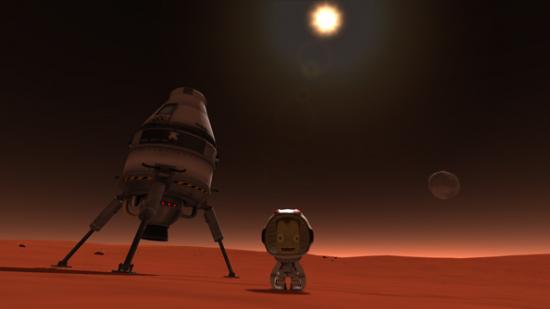While it’s touched down in alpha form, you can read our Kerbal Space Program review to see if it’s worth your buck.
I love space. All three dimensions of it: up, down and side to side. Did you know? Without space we’d all be going about our business trapped inside a singularity, bumping into one another and tutting and getting our atoms all tangled up. Of course, we couldn’t drive our cars anywhere in the singularity as there’d be nowhere else to go, so we’d only ever use cars for cool stunts and destruction derbies. Scientists theorise there’d be loads of destruction derbies in a singularity because there would be so few other forms of entertainment. Forget about fitting a television inside a singularity, for example, never mind a cinema. Another great thing about space is Kerbal Space Program, which I’ve been playing a lot of.
In Kerbal Space Program you operate your own space agency in a semi-accurate recreation of our own solar system, only with all the names of the planets changed to things like Kerbin (Earth), Duna (Mars) and Eve (Venus). You build rockets using prefab parts, by dragging and snapping together various thrusters and fuel tanks around a central command pod. It’s a fairly realistic simulation after that, employing proper flight physics and aerodynamics both inside the atmosphere and out. Just like real rockets, the most efficient designs are multi-stage, meaning that as they rise through the atmosphere they eject their spent fuel tanks and activate ever smaller boosters as they approach orbit. Kerbal Space Program lets you construct and control these kinds of dwindling, separating space-faring vehicles, the sort that comically shed two thirds of themselves every few minutes until they’re just an iPhone sized solar panel, floating in space with all wires coming out.
You can also build experimental spaceplanes for zipping about the troposphere. I’ve even seen better players attach their planes to rockets and fly off to other planets to fly around in their tropospheres, something real life space agencies are actually trying to do.
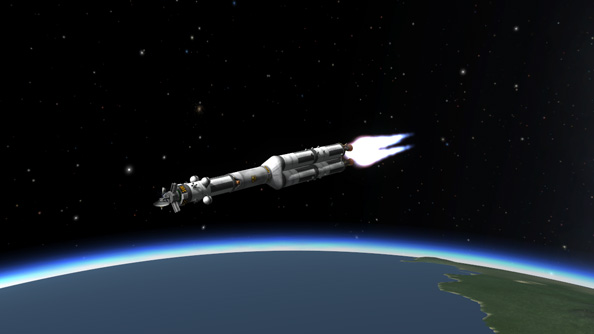
Actually, to say Kerbal Space Program lets you operate a space agency is an exaggeration, for the time being. It’s currently in alpha – available on Steam as part of its recently launched Early Access program – and as such it’s missing any sort of campaign mode or mission objective. Instead it’s a solar system exploring sandbox, one in which you’re expected to self-motivate, set your own goals and experiment with putting things into space. For example, I’m in the process of placing a terrain-mapping satellite in orbit around every planet and moon in the system, beginning with the moon and eventually reaching as far as the game’s version of Pluto. There’s plenty else to aim for. The latest versions include wheels for manned, player-controlled rovers, as well as docking ports, which allow you to construct orbital space stations and compartmentalised moon bases. Mods add even better autopilot controls as well as addiitonal ship functions, such as that terrain mapping radar I mentioned. Modders have a keen sense for what’s “cheating” and what’s not, and the most popular mods serve only to augment the experience.
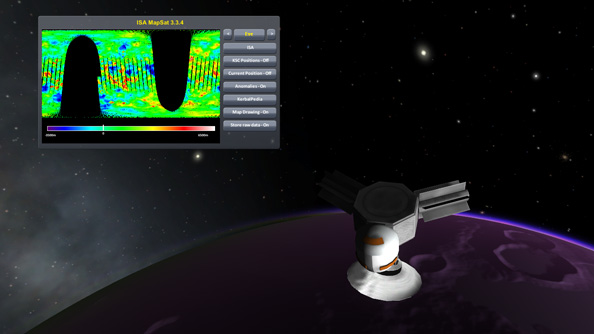
But because it’s a decent simulation, and because you are probably not a rocket scientist, you’ll spend an awful lot of time in Kerbal Space Program just watching your rockets tear themselves apart and explode mid-flight, sending your astronauts screaming back down to earth in flames. You have an endless supply of willing pilots to strap to the tops of your flammable experiments, and watching them burst into cinders miles above the planet’s surface, seeing the constituent rocket parts break away and careen through the sky like fizzling dynamite batons, is as far as many players will get with the game. And that’s fine, because explosions are cool.
But once you begin to brush the frontiers of outer space, Kerbal Space Program becomes something else entirely. Something less cartoonish and more rooted in fundamental interplanetary astrophysics (probably, I’m not a man of spacely education, it certainly feels like that might be the case). It captures the splendour and mathematical beauty of space travel like no other game by sidestepping Star Trek science fiction and wrapping its big indie arms around science fact. Getting from one planet to another isn’t achieved by pointing your cockpit towards it and putting your foot down, instead it demands a careful alignment of the phase angles of your destination planet, your ejection angle above the planet you’re departing and your ship’s limited ability to change its velocity. Brilliant nerd stuff. If I told you the best way to get to the moon you’d flip. It’s not “up”. It’s sort of spiralling outwards. There are calculators online to figure it all out, but the essential thing to note is that – just like in real life – there are ideal transfer windows to hit, and that they can be rare, taking months to arrive.
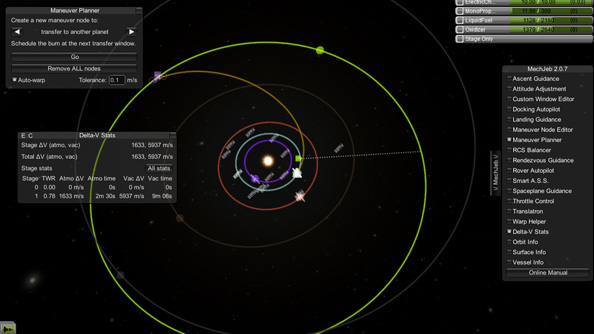
If the universe is a giant McDonalds, the solar system is one those charity spiralling coin donation boxes they used to have, the ones where you put a penny in and it spins around a two-foot wide bowl in ever tightening circles while an unblinking Ronald McDonald stares over your shoulder. We all live on a great big dirty two pence coin, perpetually spinning at some distance from the hole. Getting from our coin to another requires that we (in this metaphor, a tiny coin that breaks away from the main coin, I suppose, keep up) speed up or slow down to increase or decrease the size of the circle in which we’re spinning such that it eventually connects with the coin that you’re aiming for. Luckily, the McDonalds in which we all live is moving at a relatively slow speed, and having all the coins and McNuggets effectively trapped in bullet-time gives you plenty of room to think about exactly how fast you need to go to accurately bankshot around the sun. Space isn’t a vaccuum, it’s overflowing with maths.
If you didn’t like that analogy, you can also think of the solar system is as one of the following alternative metaphors: a cosmic billiards table, a farm where the chickens are asteroids, a bottle of coke that god dropped a Saturn-sized Mentos in, an expanding balloon at a birthday party for the Milky Way. They all probably make just as much sense as what I’ve said up until now, and can be explained to somebody in just as patronising a manner.
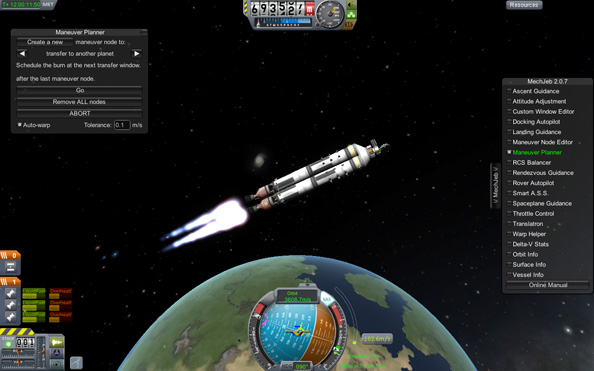
The important thing is that Kerbal Space Program goes some way to recreating the giddying pinhole accuracy of spaceflight, versus the unfathomable distances involved. A difference in speed of a few metres per second when leaving your home planet translates to a trajectory that might be ten million miles off course by the time you reach the opposite side of your solar orbit, months later. Encountering the gravity well of another heavenly body, after such arduous and fiddly configuration of your ship’s movements, after careful fine tuning of your course with controlled burns, genuinely feels like arriving at an alien world perilously far from home. You can slow your ship down by skimming across the top of a planet’s atmosphere, if it has one, and witness the re-entry flames flicker around the scorched, ruggedised edges of your craft. Or you can slingshot around a moon to adjust your course, using its mass to speed up or slow down without spending any fuel — just as Voyager did when it pirhouetted around Jupiter like an interstellar dandy.
Because of the reliance on invisible maths, trigonometry and charts to move anywhere in space, it’s these abruptly physical space-tricks, the atmospheric breaking, the breakneck lunar slingshots, hitting a mote of dust a billion miles away, docking with a station that’s orbiting at two miles per second, erupting into flames in an alien atmosphere, that resonate with most romantic notions of space travel. That just wouldn’t be possible in a rocket game that wasn’t precisely this ambitious in its realistic depiction of a proper, physical, tumbling system of planets and moons. With little green men.
By conceding very little to science-fiction and being so staunchly challenging in every aspect, Kerbal Space Program becomes one of the most rewarding games I’ve ever played. Development is slow, modders swarm to fill in gaps and the community are pulling in two directions: half want a more developed simulator, half want a more developed game with a better career mode. The list of upcoming changes is heartening either way, with plans to broaden the space program’s frontier even farther, to touch other solar systems and maybe even one day depart the galaxy and explore the universe beyond. They’re thinking big.
This isn’t a review, because Kerbal Space Program isn’t finished yet, but it is a rough surmisal of the merits of the game as it stands versus its potential to grow and change as time passes. Or something like that. If you love space and hate singularities, then this is probably a program you should be part of at any stage of its gestation.
